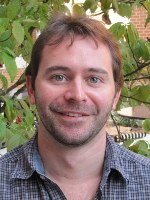Past NIMBioS Postdoctoral Fellow
Ryan Martin
 Dates: September 2012 – December 2013
Dates: September 2012 – December 2013
Lab web page
Project Title: Understanding the causes of phenotypic selection in the wild
As a NIMBioS postdoctoral fellow, Ryan Martin (Ph.D. Biology, Univ. of North Carolina at Chapel Hill, 2010) explored patterns between agents of selection and estimates of phenotypic selection from natural populations and manipulative experiments in order to gain a more thorough understanding of the causes of selection in the wild. Surprisingly little is known about the causes (or “agents”) of natural and sexual selection: the environmental conditions, ecological, and social interactions that produce differential fitness between individuals. As a consequence, there is a general lack of understanding of how agents of selection might differ in causing phenotypic selection, and thus evolutionary change. Martin, in collaboration with colleagues from a NESCent working group, first compiled large databases of phenotypic selection estimates, environmental data, and details of experimental methodology from previous published studies. Martin and his colleagues then used meta-analytical techniques to evaluate the relative importance of different agents of selection across different traits, taxa, sexes, life-stages, and geographic locations, how they might interact, and if biases exist in experimental studies manipulating agents of selection.
Martin has also been involved with other projects ranging from the studying the effect of relatedness on resource competition (Martin and Garnett 2013), the determinants of offspring survival in a vulnerable gazelle species (Riesch et al. 2013), and the ecological causes of evolutionary divergence in sexually dimorphic coloration in Bahamas mosquitofish (Martin et al. in press). Upon completing his fellowship at NIMBioS, Dr. Martin accepted a position in the Department of Biology at Case Western Reserve University in Cleveland, Ohio.
Visit Dr. Martin's lab web page.
LiveScience Profile Q&A with Dr. Martin: Agents of selection: Scientist synthesizes the myriad causes
NIMBioS Seminar: Ecological causes of phenotypic selection and divergence
Video Interview:
Selection in the wild
Publications while at NIMBioS
Caruso CM et al. 2017. What are the environmental determinants of phenotypic selection? A meta-analysis of experimental studies. The American Naturalist. 2017 Sep 1;190(3):000-000.
Siepielski AM et al. 2017. Precipitation drives global variation on natural selection. Science, 355(6328): 959-62. [Online]
Martin RA, McGee MD, Langerhans RB. 2015. Predicting ecological and phenotypic differentiation in the wild: A case of piscivorous fish in a fishless environment. Biological Journal fo the Linnean Society, 114(3): 588-607. [Online]
Martin RA, Garnett SC. 2013. Relatedness and resource diversity interact to influence the intensity of competition. Biological Journal of the Linnean Society, 110(3): 689-695. [Online]
Martin RA, Langerhans RB. 2013. Piscivorous fish in a fishless environment: Dietary and phenotypic differentiation of bigmouth sleepers in Bahamas blue holes. Integrative and Comparative Biology, 53(1): E138. [Online].
Riesch R, Martin RA, Lerp H, Plath M, Wronski T. 2013. Size and sex matter: Reproductive biology and determinants of offspring survival in Gazella marica. Biological Journal of the Linnean Society, 110(1): 116-127. [Online]
Martin RA, Riesch R, Heinen-Kay JL, Langerhans RB. Evolution of male coloration during a post-pleistocene radiation of bahama's mosquitofish (Gambusia hubbsi). Evolution, 68(2): 397-411. [Online]
Presentations while at NIMBioS
Martin RA, Langerhans RB. 2013. Piscivorous fish in a fishless environment: Dietary and phenotypic differentiation of bigmouth sleepers in Bahamas blue holes. Society for Integrative and Comparative Biology.
Martin RA. 2013. Ecological causes of selection and divergence. Dept. of Biology, Case Western Reserve University.
Martin R. 19 March 2013. Ecological causes of phenotypic selection and divergence. NIMBioS Seminar Series, NIMBioS, University of Tennessee, Knoxville, TN. [Online].
Martin RA. 2012. Disruptive selection and the evolution of resource polymorphism. HOFF lab group meeting, Dept of Ecology & Evolutionary Biology, University of Tennessee, Knoxville, TN.
Education, Outreach and Training
Outreach and Education Activities
Student mentoring. Informally involved a UT-Knoxville undergraduate during the summer 2013 with reading through peer-reviewed papers and extracting data for a meta analysis.
Assisted with Gresham Middle School‘s Beta Club visit to NIMBioS, May 2013
NIMBioS Postdoc Career Development Seminars
NIMBioS Interdisciplinary Seminars
Univ. of Tennessee Department of Ecology and Evolutionary Biology (EEB) Seminars
Informal workshops on job applications EEB's Paul Armsworth
EEB's Brian O'Meara lab meetings HOFF (EEB's C. Darrin Hulsey, Brian O'Meara, James Fordyce, Ben Fitzpatrick) lab meetings
NIMBioS
1122 Volunteer Blvd., Suite 106
University of Tennessee
Knoxville,
TN 37996-3410
PH: (865) 974-9334
FAX: (865) 974-9461
Contact NIMBioS


